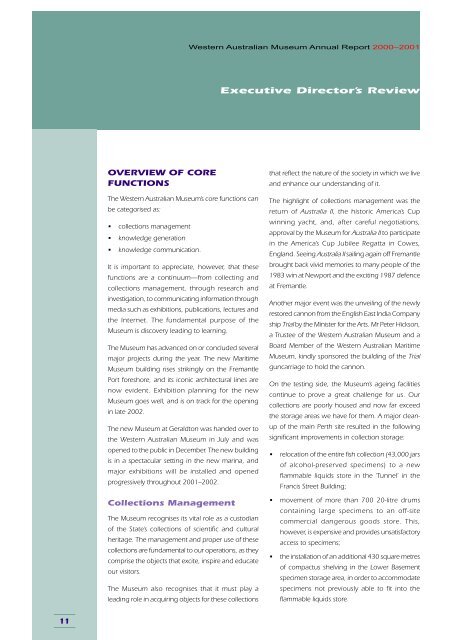Annual Report-2000-2001 - Western Australian Museum - The ...
Annual Report-2000-2001 - Western Australian Museum - The ...
Annual Report-2000-2001 - Western Australian Museum - The ...
You also want an ePaper? Increase the reach of your titles
YUMPU automatically turns print PDFs into web optimized ePapers that Google loves.
11<br />
OVERVIEW OF CORE<br />
FUNCTIONS<br />
<strong>The</strong> <strong>Western</strong> <strong>Australian</strong> <strong>Museum</strong>’s core functions can<br />
be categorised as:<br />
• collections management<br />
• knowledge generation<br />
• knowledge communication.<br />
It is important to appreciate, however, that these<br />
functions are a continuum—from collecting and<br />
collections management, through research and<br />
investigation, to communicating information through<br />
media such as exhibitions, publications, lectures and<br />
the Internet. <strong>The</strong> fundamental purpose of the<br />
<strong>Museum</strong> is discovery leading to learning.<br />
<strong>The</strong> <strong>Museum</strong> has advanced on or concluded several<br />
major projects during the year. <strong>The</strong> new Maritime<br />
<strong>Museum</strong> building rises strikingly on the Fremantle<br />
Port foreshore, and its iconic architectural lines are<br />
now evident. Exhibition planning for the new<br />
<strong>Museum</strong> goes well, and is on track for the opening<br />
in late 2002.<br />
<strong>The</strong> new <strong>Museum</strong> at Geraldton was handed over to<br />
the <strong>Western</strong> <strong>Australian</strong> <strong>Museum</strong> in July and was<br />
opened to the public in December. <strong>The</strong> new building<br />
is in a spectacular setting in the new marina, and<br />
major exhibitions will be installed and opened<br />
progressively throughout <strong>2001</strong>–2002.<br />
Collections Management<br />
<strong>The</strong> <strong>Museum</strong> recognises its vital role as a custodian<br />
of the State’s collections of scientific and cultural<br />
heritage. <strong>The</strong> management and proper use of these<br />
collections are fundamental to our operations, as they<br />
comprise the objects that excite, inspire and educate<br />
our visitors.<br />
<strong>The</strong> <strong>Museum</strong> also recognises that it must play a<br />
leading role in acquiring objects for these collections<br />
<strong>Western</strong> <strong>Australian</strong> <strong>Museum</strong> <strong>Annual</strong> <strong>Report</strong> <strong>2000</strong>–<strong>2001</strong><br />
Executive Director’s Review<br />
that reflect the nature of the society in which we live<br />
and enhance our understanding of it.<br />
<strong>The</strong> highlight of collections management was the<br />
return of Australia II, the historic America’s Cup<br />
winning yacht, and, after careful negotiations,<br />
approval by the <strong>Museum</strong> for Australia II to participate<br />
in the America’s Cup Jubilee Regatta in Cowes,<br />
England. Seeing Australia II sailing again off Fremantle<br />
brought back vivid memories to many people of the<br />
1983 win at Newport and the exciting 1987 defence<br />
at Fremantle.<br />
Another major event was the unveiling of the newly<br />
restored cannon from the English East India Company<br />
ship Trial by the Minister for the Arts. Mr Peter Hickson,<br />
a Trustee of the <strong>Western</strong> <strong>Australian</strong> <strong>Museum</strong> and a<br />
Board Member of the <strong>Western</strong> <strong>Australian</strong> Maritime<br />
<strong>Museum</strong>, kindly sponsored the building of the Trial<br />
guncarriage to hold the cannon.<br />
On the testing side, the <strong>Museum</strong>’s ageing facilities<br />
continue to prove a great challenge for us. Our<br />
collections are poorly housed and now far exceed<br />
the storage areas we have for them. A major cleanup<br />
of the main Perth site resulted in the following<br />
significant improvements in collection storage:<br />
• relocation of the entire fish collection (43,000 jars<br />
of alcohol-preserved specimens) to a new<br />
flammable liquids store in the ‘Tunnel’ in the<br />
Francis Street Building;<br />
• movement of more than 700 20-litre drums<br />
containing large specimens to an off-site<br />
commercial dangerous goods store. This,<br />
however, is expensive and provides unsatisfactory<br />
access to specimens;<br />
• the installation of an additional 430 square metres<br />
of compactus shelving in the Lower Basement<br />
specimen storage area, in order to accommodate<br />
specimens not previously able to fit into the<br />
flammable liquids store.

















